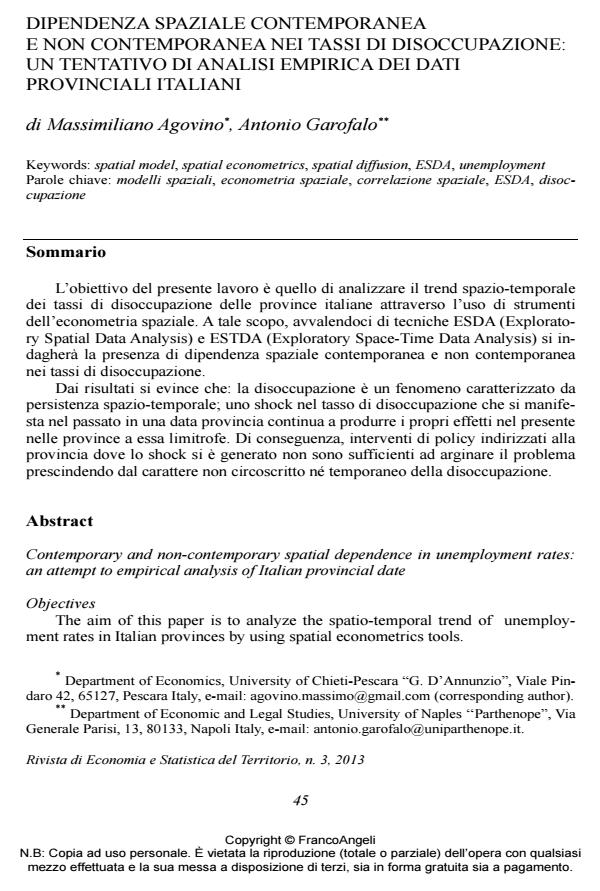Contemporary and non-contemporary spatial dependence in unemployment rates: an attempt to empirical analysis of Italian provincial date
Journal title RIVISTA DI ECONOMIA E STATISTICA DEL TERRITORIO
Author/s Massimiliano Agovino, Antonio Garofalo
Publishing Year 2014 Issue 2013/3
Language Italian Pages 38 P. 45-82 File size 1309 KB
DOI 10.3280/REST2013-003002
DOI is like a bar code for intellectual property: to have more infomation
click here
Below, you can see the article first page
If you want to buy this article in PDF format, you can do it, following the instructions to buy download credits

FrancoAngeli is member of Publishers International Linking Association, Inc (PILA), a not-for-profit association which run the CrossRef service enabling links to and from online scholarly content.
The aim of this paper is to analyze the spatio-temporal trend of unemployment rates in Italian provinces by using spatial econometrics tools. Methods and Results To this purpose, we investigate the existence of contemporary and noncontemporary spatial dependence in unemployment rates by employing ESDA (Exploratory Spatial Data Analysis) and ESTDA (Exploratory Space-Time Data Analysis) techniques. Our results show that: unemployment is a phenomenon characterized by space-time persistence; a shock in the unemployment rate, which occurs in the past and in a given province, produces its effects in the present in the neighbouring provinces. Conclusions: As a consequence, economic policy measures addressed to the province where the shock is generated are not sufficient to tackle the problem since unemployment is neither a localized or a temporary phenomenon.
Keywords: Spatial model, spatial econometrics, spatial diffusion, ESDA, unemployment
Jel codes: C21, C51, C53, J08, J64
- The Probability Density Function of Interest Rates Implied in the Price of Options Fabio Fornari, Roberto Violi, in SSRN Electronic Journal /1998
DOI: 10.2139/ssrn.899976
Massimiliano Agovino, Antonio Garofalo, Dipendenza spaziale contemporanea e non contemporanea nei tassi di disoccupazione: un tentativo di analisi empirica dei dati provinciali italiani in "RIVISTA DI ECONOMIA E STATISTICA DEL TERRITORIO" 3/2013, pp 45-82, DOI: 10.3280/REST2013-003002